Energy-Saving Optimization of HVAC Systems Using an Ant Lion Optimizer with Enhancements
Abstract
1. Introduction
1.1. Background
1.2. Literature Review
1.3. The Overview of This Paper
2. Methodology
2.1. Standard Ant Lion Optimizer
- (1)
- Initialize Population
- (2)
- Random Walk
- (3)
- Hunting Behavior
2.2. Ant Lion Optimizer with Enhancements
2.2.1. The Levy Flight of the Ant Mechanism
2.2.2. The Adaptive Elite Guidance Mechanism
2.2.3. Dynamic Cauchy Variation Mechanism
2.2.4. Algorithm Flow
- (a)
- Initialize the positions of the ant and antlion populations, and .
- (b)
- Calculate the fitness of the ants and antlions, and , select the elite antlion , and save its position.
- (c)
- Use the roulette wheel to select the antlion around which each ant will walk.
- (d)
- The ants perform Levy flights around and .
- (e)
- Dynamically balance the walks around and according to the adaptive elite strategy.
- (f)
- Update the positions of the ants and calculate their fitness .
- (g)
- The ants fall into traps, and the antlions prey on the ants, updating their positions according to Equation (8).
- (h)
- Update the fitness of the antlions and apply the Cauchy mutation to the antlions with the lowest fitness.
- (i)
- Compare the fitness of the best antlion with the elite antlion, and if the former is better, update the elite antlion .
3. Case Study
3.1. System Background
3.2. Data Description
3.3. System Modeling
3.3.1. Model for Chiller
3.3.2. Model for Cooling/Chilled Water Pump
3.3.3. Model for Cooling Tower
3.3.4. System Energy Consumption Model
4. Experiment
4.1. Experimental Setting
4.1.1. Hyperparameters
4.1.2. Evaluation Metrics
4.2. Comparison of Energy-Saving Optimization Results
4.3. Typical Day Analysis
5. Conclusions
Author Contributions
Funding
Data Availability Statement
Conflicts of Interest
References
- China Association of Building Energy Efficiency. China Building Energy Consumption and Carbon Emissions Research Report (2022). Constr. Archit. 2023, 2, 57–69. [Google Scholar]
- Miao, Y.; Yao, Y.; Hong, X.; Xiong, L.; Zhang, F.; Chen, W. Research on optimal control of HVAC system using swarm intelligence algorithms. Build. Environ. 2023, 241, 110467. [Google Scholar] [CrossRef]
- Farahnak, M.; Farzaneh-Gord, M.; Deymi-Dashtebayaz, M.; Dashti, F. Optimal sizing of power generation unit capacity in ICE-driven CCHP systems for various residential building sizes. Appl. Energy 2015, 158, 203–219. [Google Scholar] [CrossRef]
- Kohlenbach, P.; Ziegler, F. A dynamic simulation model for transient absorption chiller performance. Part I: The model. Int. J. Refrig. 2008, 31, 217–225. [Google Scholar] [CrossRef]
- Wemhoff, A.; Frank, M. Predictions of energy savings in HVAC systems by lumped models. Energy Build. 2010, 42, 1807–1814. [Google Scholar] [CrossRef]
- Vakiloroaya, V.; Samali, B.; Madadnia, J.; Ha, Q. Component-wise optimization for a commercial central cooling plant. In Proceedings of the IECON 2011-37th Annual Conference of the IEEE Industrial Electronics Society, Melbourne, Australia, 7–10 November 2011; pp. 2769–2774. [Google Scholar]
- Park, M.H.; Shin, E.G.; Lee, H.R.; Suh, I.S. Dynamic model and control algorithm of HVAC system for OLEV® application. In Proceedings of the ICCAS 2010, Gyeonggi-do, Republic of Korea, 27–30 October 2010; pp. 1312–1317. [Google Scholar]
- Terzi, E.; Fagiano, L.; Farina, M.; Scattolini, R. Structured modelling from data and optimal control of the cooling system of a large business center. J. Build. Eng. 2020, 28, 101043. [Google Scholar] [CrossRef]
- Afram, A.; Janabi-Sharifi, F.; Fung, A.S.; Raahemifar, K. Artificial neural network (ANN) based model predictive control (MPC) and optimization of HVAC systems: A state of the art review and case study of a residential HVAC system. Energy Build. 2017, 141, 96–113. [Google Scholar] [CrossRef]
- Yao, Y.; Lian, Z.; Hou, Z.; Zhou, X. Optimal operation of a large cooling system based on an empirical model. Appl. Therm. Eng. 2004, 24, 2303–2321. [Google Scholar] [CrossRef]
- Lu, L.; Cai, W.; Xie, L.; Li, S.; Soh, Y.C. HVAC system optimization—In-building section. Energy Build. 2005, 37, 11–22. [Google Scholar] [CrossRef]
- Xiaomei, F.; Qifei, J.; Zheng, Z. Analysis on Energy-saving of Year-round Operation Conditions with Variable Flow Cooling Water System. Build. Sci. 2010, 26, 80–84. [Google Scholar]
- Yang, C.; Gunay, B.; Shi, Z.; Shen, W. Machine learning-based prognostics for central heating and cooling plant equipment health monitoring. IEEE Trans. Autom. Sci. Eng. 2020, 18, 346–355. [Google Scholar] [CrossRef]
- Krinidis, S.; Tsolakis, A.; Katsolas, I.; Ioannidis, D.; Tzovaras, D. Multi-criteria HVAC control optimization. In Proceedings of the 2018 IEEE International Energy Conference (ENERGYCON), Limassol, Cyprus, 3–7 June 2018; pp. 1–6. [Google Scholar]
- Barrett, E.; Linder, S. Autonomous hvac control, a reinforcement learning approach. In Proceedings of the Machine Learning and Knowledge Discovery in Databases: European Conference, ECML PKDD 2015, Porto, Portugal, 7–11 September 2015; Proceedings, Part III 15. Springer: Berlin/Heidelberg, Germany, 2015; pp. 3–19. [Google Scholar]
- Afroz, Z.; Shafiullah, G.; Urmee, T.; Shoeb, M.; Higgins, G. Predictive modelling and optimization of HVAC systems using neural network and particle swarm optimization algorithm. Build. Environ. 2022, 209, 108681. [Google Scholar] [CrossRef]
- Mirjalili, S. The ant lion optimizer. Adv. Eng. Softw. 2015, 83, 80–98. [Google Scholar] [CrossRef]
- Wang, L.; Cao, Q.; Zhang, Z.; Mirjalili, S.; Zhao, W. Artificial rabbits optimization: A new bio-inspired meta-heuristic algorithm for solving engineering optimization problems. Eng. Appl. Artif. Intell. 2022, 114, 105082. [Google Scholar] [CrossRef]
- Rahkar Farshi, T. Battle royale optimization algorithm. Neural Comput. Appl. 2021, 33, 1139–1157. [Google Scholar] [CrossRef]
- Agushaka, J.O.; Ezugwu, A.E.; Abualigah, L. Dwarf mongoose optimization algorithm. Comput. Methods Appl. Mech. Eng. 2022, 391, 114570. [Google Scholar] [CrossRef]
- Azizi, M.; Aickelin, U.; Khorshidi, H.A.; Baghalzadeh Shishehgarkhaneh, M. Energy valley optimizer: A novel metaheuristic algorithm for global and engineering optimization. Sci. Rep. 2023, 13, 226. [Google Scholar] [CrossRef] [PubMed]
- Mohamed, A.W.; Hadi, A.A.; Mohamed, A.K. Gaining-sharing knowledge based algorithm for solving optimization problems: A novel nature-inspired algorithm. Int. J. Mach. Learn. Cybern. 2020, 11, 1501–1529. [Google Scholar] [CrossRef]
- Askari, Q.; Saeed, M.; Younas, I. Heap-based optimizer inspired by corporate rank hierarchy for global optimization. Expert Syst. Appl. 2020, 161, 113702. [Google Scholar] [CrossRef]
- Trojovskỳ, P.; Dehghani, M. Walrus optimization algorithm: A new bio-inspired metaheuristic algorithm. Preprint 2022. [Google Scholar] [CrossRef]
- Amali, D.; Dinakaran, M. Wildebeest herd optimization: A new global optimization algorithm inspired by wildebeest herding behaviour. J. Intell. Fuzzy Syst. 2019, 37, 8063–8076. [Google Scholar] [CrossRef]
- Terzi, E.; Cataldo, A.; Lorusso, P.; Scattolini, R. Modelling and predictive control of a recirculating cooling water system for an industrial plant. J. Process Control 2018, 68, 205–217. [Google Scholar] [CrossRef]
- Saxena, P.; Kothari, A. Ant lion optimization algorithm to control side lobe level and null depths in linear antenna arrays. AEU-Int. J. Electron. Commun. 2016, 70, 1339–1349. [Google Scholar] [CrossRef]
- Reynolds, A. Liberating Lévy walk research from the shackles of optimal foraging. Phys. Life Rev. 2015, 14, 59–83. [Google Scholar] [CrossRef]
- Yao, X.; Liu, Y.; Lin, G. Evolutionary programming made faster. IEEE Trans. Evol. Comput. 1999, 3, 82–102. [Google Scholar]
- Jensi, R.; Jiji, G.W. An enhanced particle swarm optimization with levy flight for global optimization. Appl. Soft Comput. 2016, 43, 248–261. [Google Scholar] [CrossRef]
- Han, X.M.; Qiu, B.; Liu, Q.M.; Zhou, L.Y.; Wang, L.M. Fruit fly optimization algorithm based on Cauchy mutation. Microelectron. Comput. 2017, 34, 26–30. [Google Scholar]
- Tashtoush, B.; Molhim, M.; Al-Rousan, M. Dynamic model of an HVAC system for control analysis. Energy 2005, 30, 1729–1745. [Google Scholar] [CrossRef]
- Wijaya, T.K.; Alhamid, M.I.; Saito, K.; Nasruddin, N. Dynamic optimization of chilled water pump operation to reduce HVAC energy consumption. Therm. Sci. Eng. Prog. 2022, 36, 101512. [Google Scholar] [CrossRef]
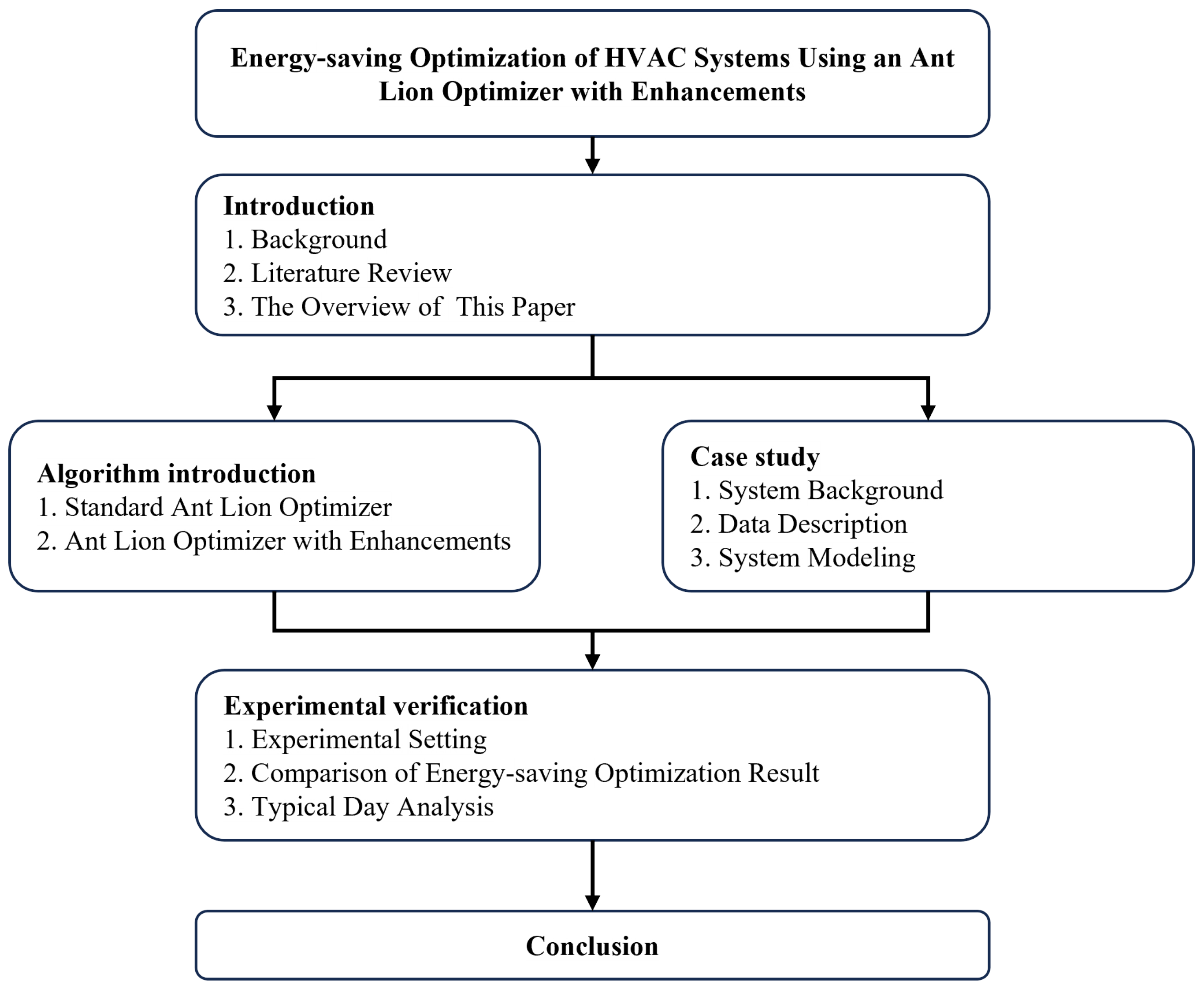
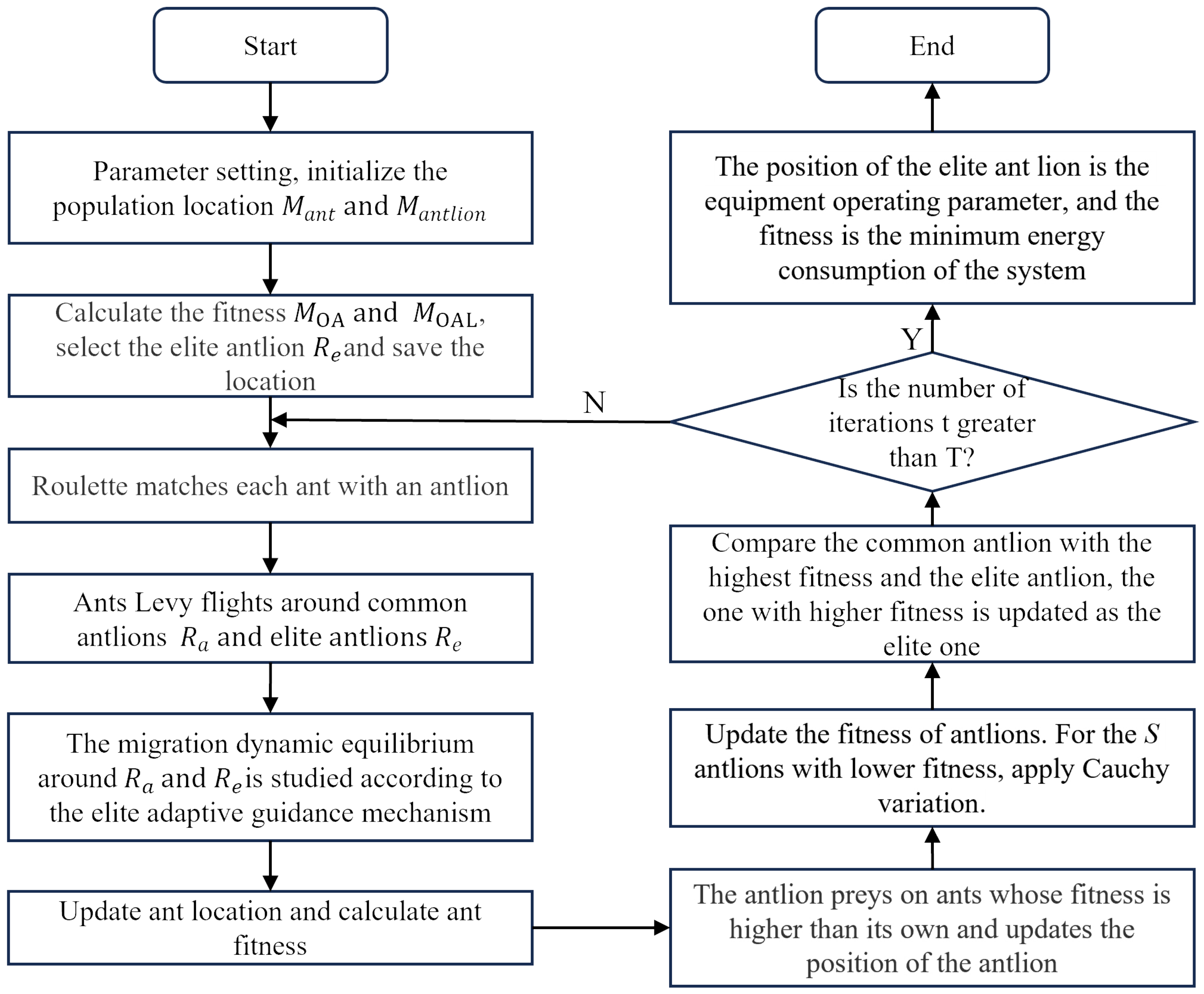
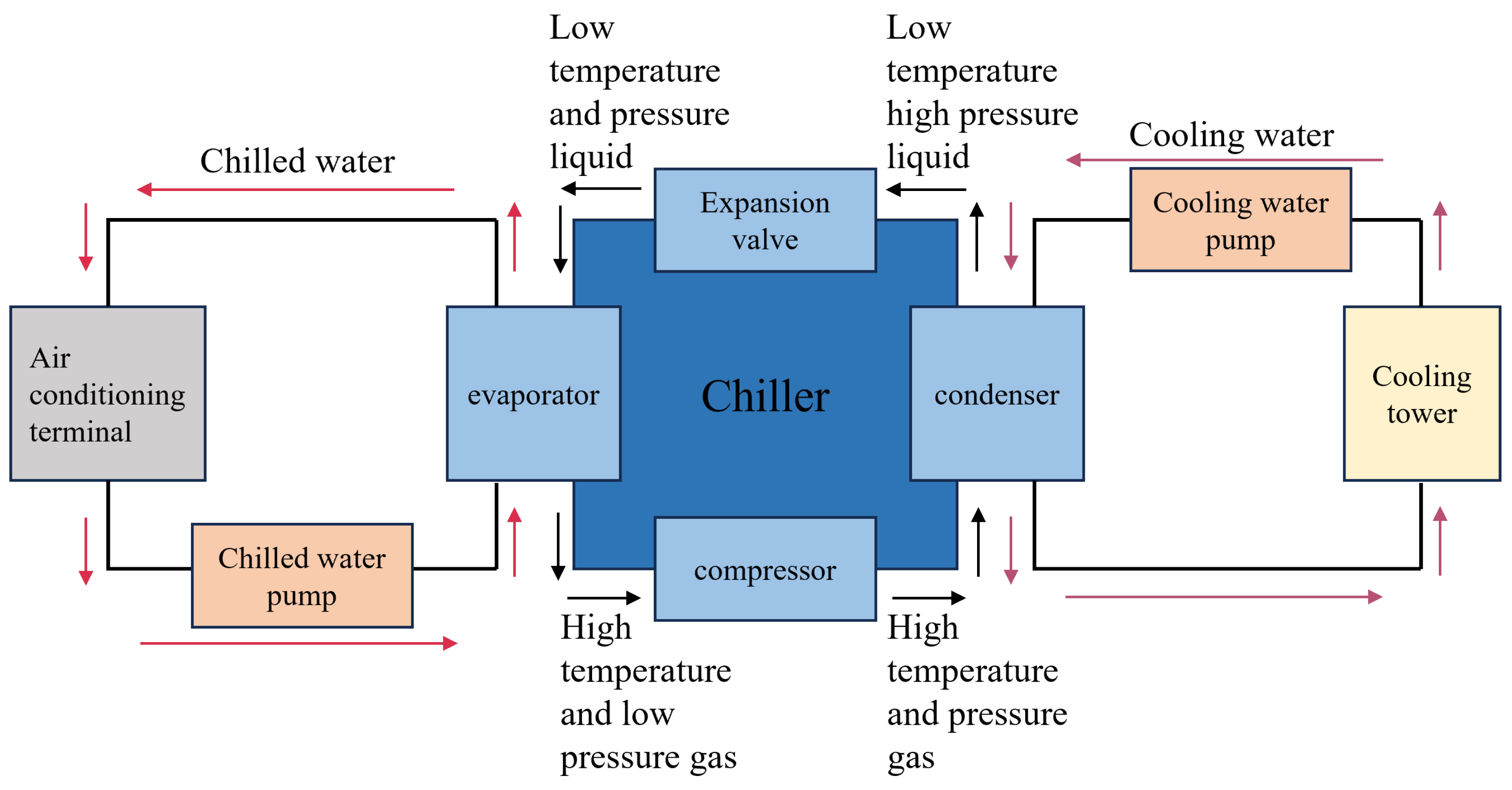


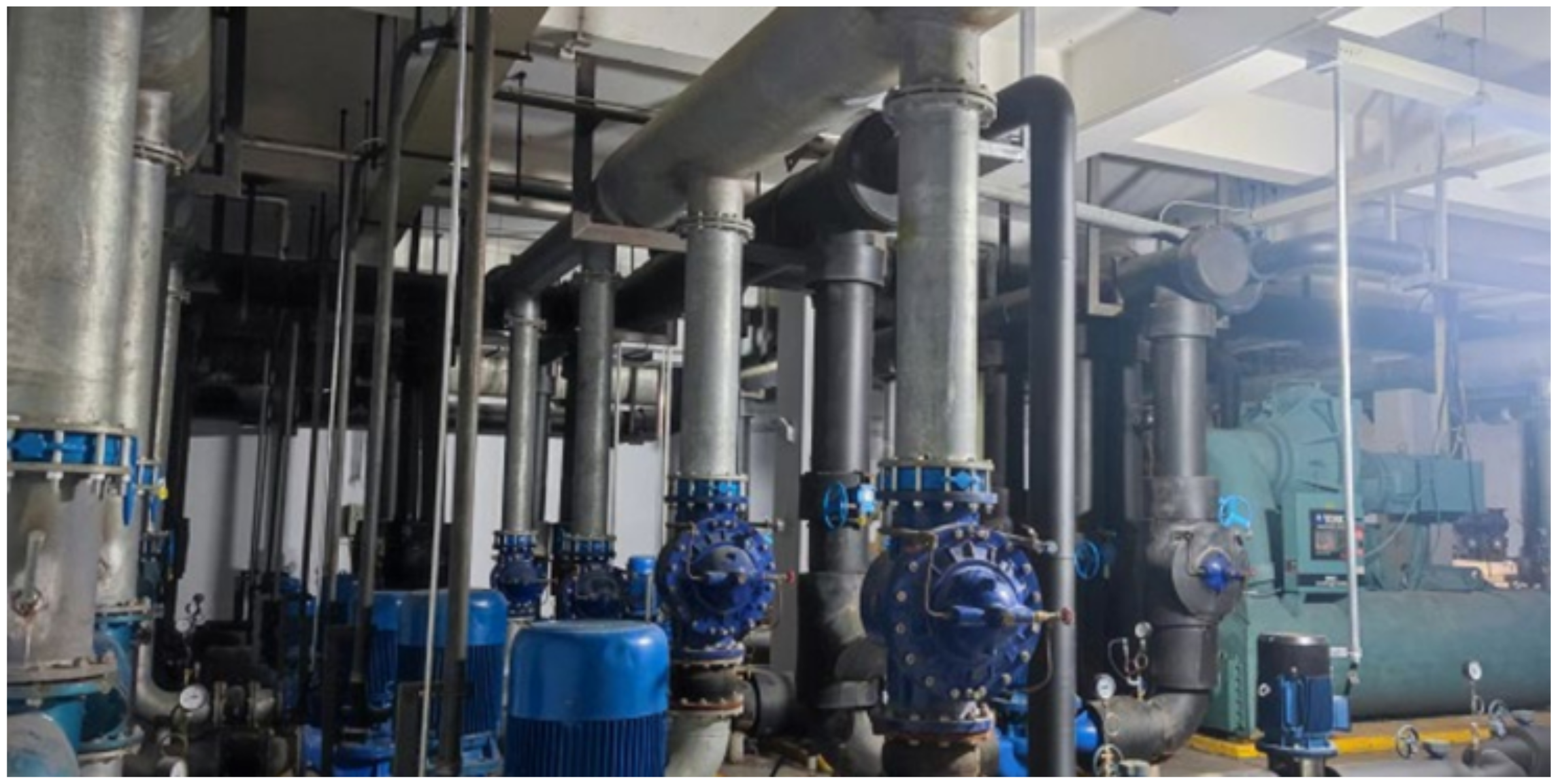
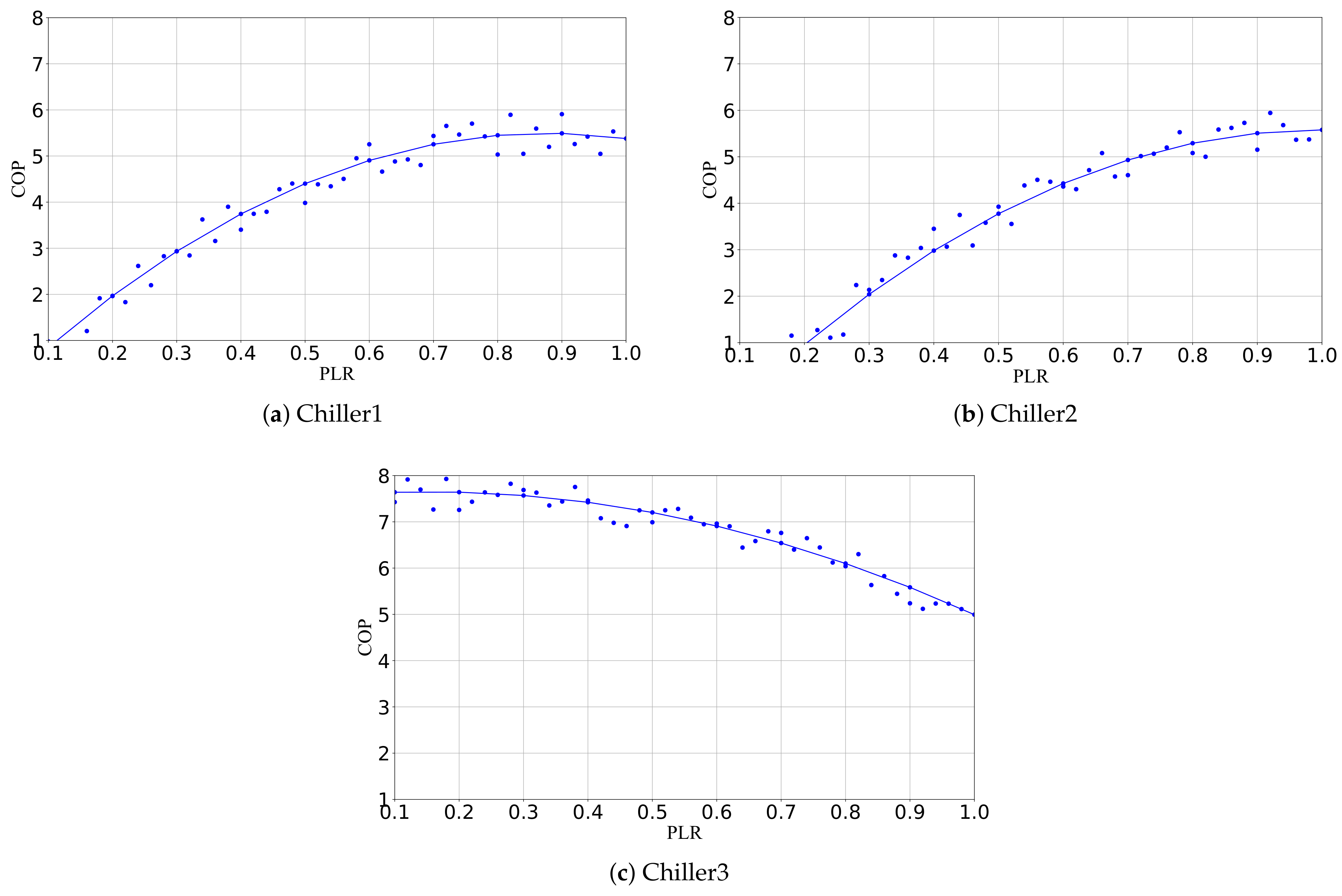
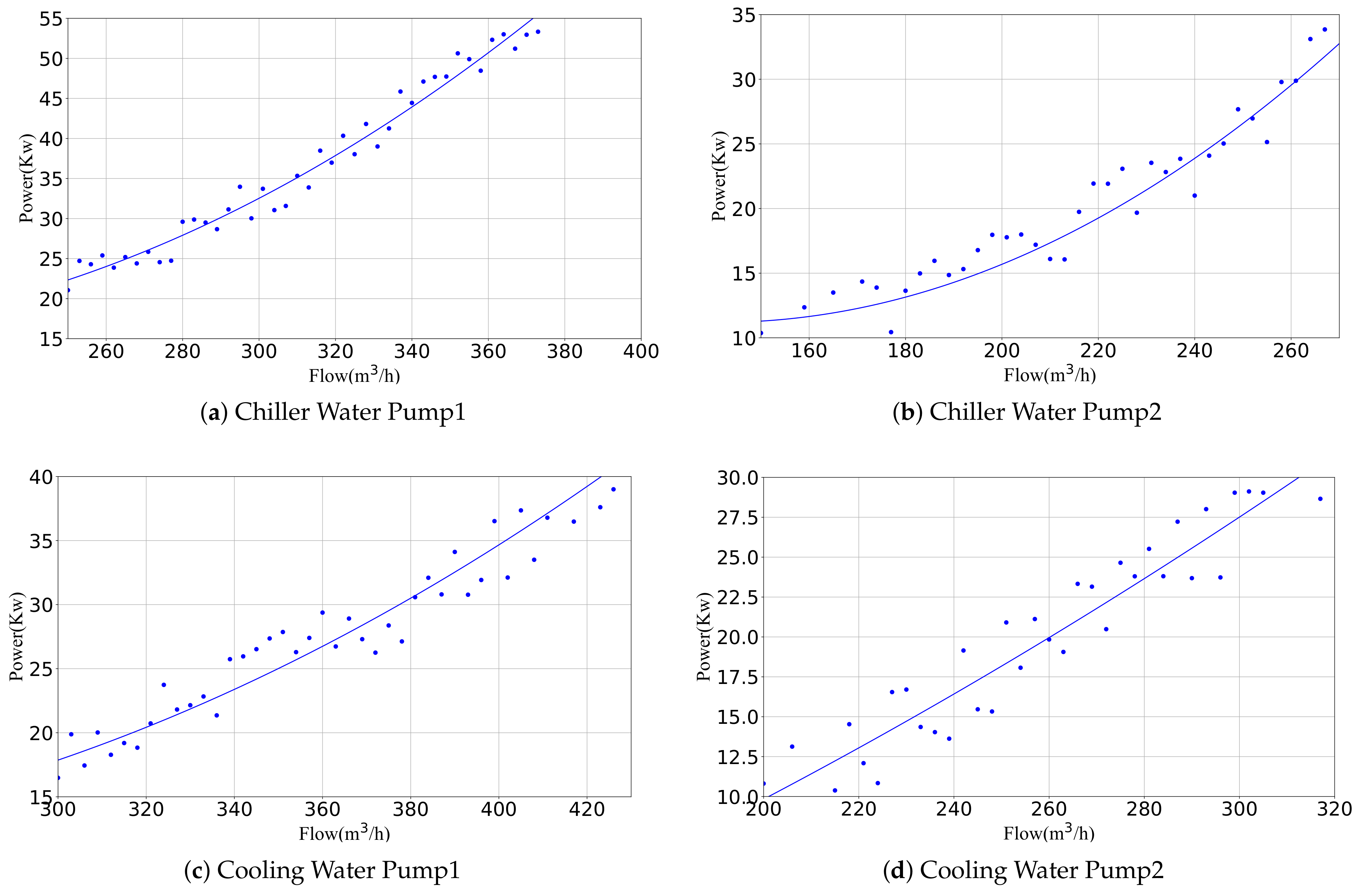

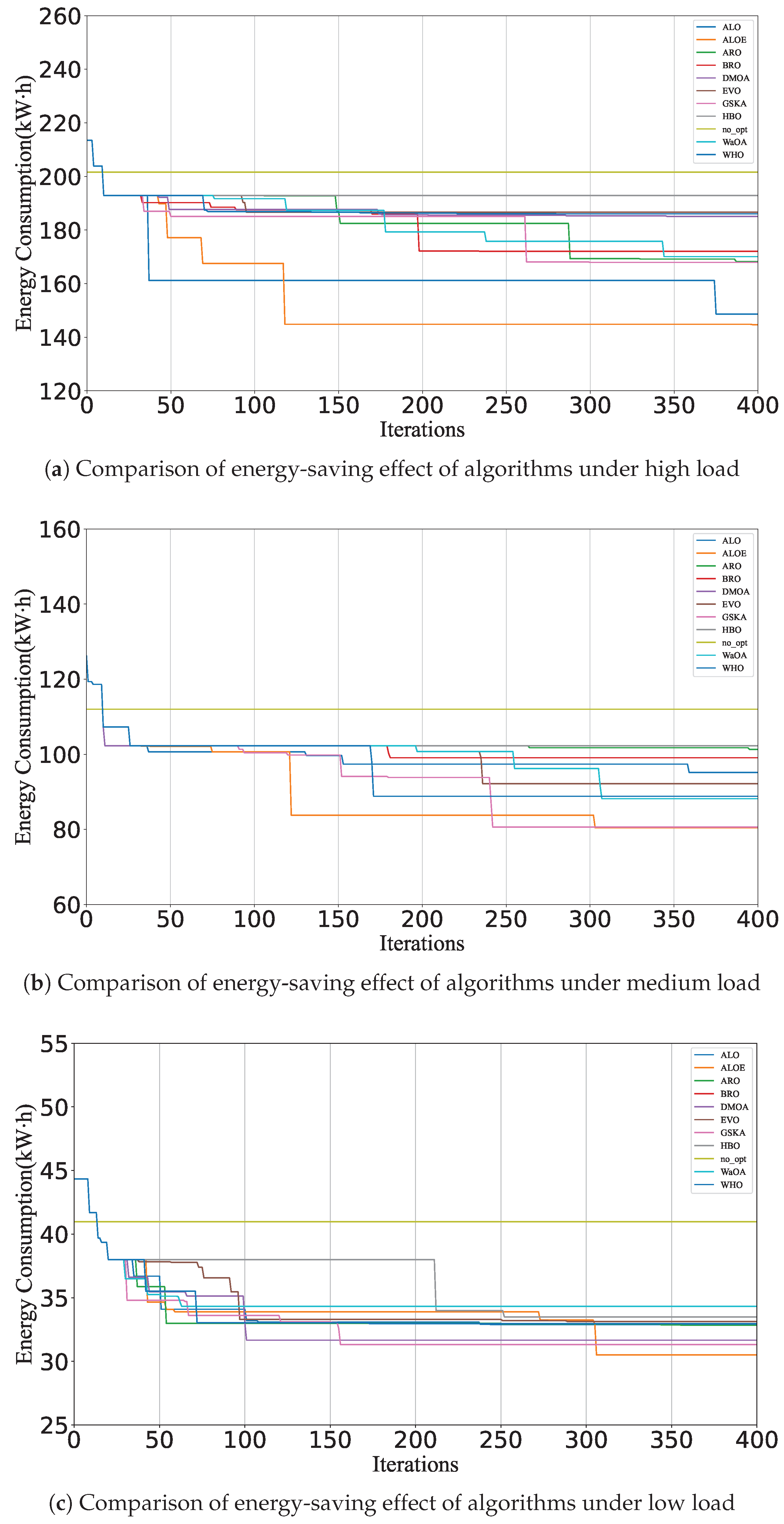
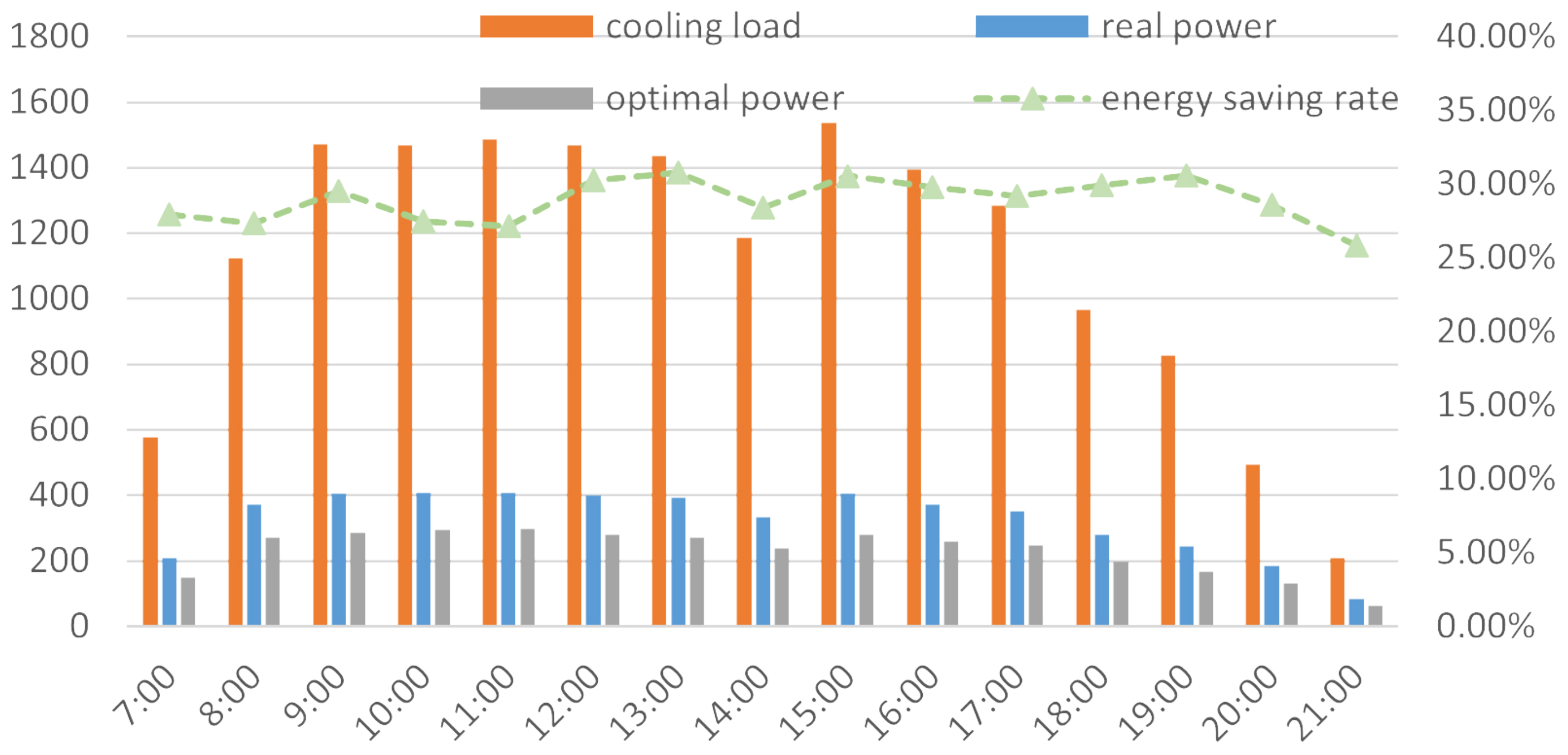
| Problem Type | Method Type | References | Limitations |
|---|---|---|---|
| System Energy Consumption Modeling | mechanistic modeling | [4,5,6,7] | Requires extensive domain-specific expertise, time, and high technical costs. |
| data-driven modeling | [8,9] | Requires large amounts of data and computational resources, and is difficult to transfer to new application scenarios. | |
| HVAC System Optimization Methods | Traditional Methods | [10,11,12] | Difficult for traditional optimization algorithms based on expert experience to handle the high complexity and strong coupling of internal factors in HVAC systems. |
| Machine Learning | [13,14,15,16] | High computational resource demand, large deviations in system operation data, and data quality is hard to meet requirements. | |
| Swarm intelligence optimization | [2,17,18,19,20,21,22,23,24,25] | The structure of the algorithm is complex, the parameters are large, and a large number of random individuals increase the invalid calculation and reduce the efficiency of the algorithm. |
| Equipment Type | Parameters | Quantity |
|---|---|---|
| Chiller1 | Rated cooling capacity 1934 kW, rated power 336 kw | 1 |
| Chiller2 | Rated cooling capacity 1135 kW, rated power 261 kw | 1 |
| Chiller3 | Rated cooling capacity 353.5 kW, rated power 74 kw | 1 |
| Chilled water pump | Rated flow 80 m3/h, rated power 15 kw | 1 |
| Chilled water pump | Rated flow 200 m3/h, rated power 30 kw | 2 |
| Chilled water pump | Rated flow 400 m3/h, rated power 55 kw | 2 |
| Cooling water pump | Rated flow 250 m3/h, rated power 30 kw | 2 |
| Cooling water pump | Rated flow 450 m3/h, rated power 45 kw | 2 |
| Cooling Tower | Rated flow 250 m3/h, rated power 7.5 kw | 4 |
| Algorithm | Parameter | Function | Value |
|---|---|---|---|
| BRO [19] | threshold | dead threshold | 3 |
| DMOA [20] | n_baby_sitter | number of babysitters | 3 |
| peep | define vocalization coeff | 2 | |
| GSKA [22] | pb | percent of the best | 0.1 |
| kr | knowledge ratio | 0.7 | |
| HBO [23] | degree | the degree level in corporate rank hierarchy | 2 |
| WHO [25] | n_explore_step | number of exploration step | 3 |
| n_exploit_step | number of exploitation step | 3 | |
| eta | learning rate the | 0.15 | |
| probability of wildebeest | |||
| p_hi | move to another position | 0.9 | |
| based on herd instinct | |||
| local_alpha | control local movement | 0.9 | |
| local_beta | control local movement | 0.3 | |
| global_alpha | control global movement | 0.2 | |
| global_beta | control global movement | 0.8 | |
| delta_w | dist to worst | 2.0 | |
| delta_c | dist to best | 2.0 |
| Case | Temperature | Humidity | Result | CHW Pump | CW Pump | Cooling Tower | Chiller | System |
|---|---|---|---|---|---|---|---|---|
| High | 34.28 | 35.78 | Actual Predicted Error | 27.62 | 20.40 | 10.28 | 156.00 | 214.28 |
| 27.48 | 22.55 | 12.97 | 139.60 | 201.60 | ||||
| 0.36% | 10.39% | 16.73% | 10.51% | 5.92% | ||||
| Medium | 30.53 | 54.22 | Actual Predicted Error | 28.77 | 26.13 | 4.21 | 51.75 | 110.87 |
| 27.74 | 24.02 | 4.60 | 55.64 | 112.00 | ||||
| 3.60% | 8.10% | 9.38% | 7.51% | 1.02% | ||||
| Low | 32.26 | 43.18 | Actual Predicted Error | 6.62 | 10.11 | 1.78 | 19.52 | 38.03 |
| 6.27 | 9.84 | 1.74 | 22.74 | 40.60 | ||||
| 5.26 | 2.62 | 2.32 | 16.50 | 6.74 | ||||
| - | - | - | Mean Error | 3.07% | 7.00% | 9.48% | 11.51% | 4.56% |
| Case | Result | ALO [17] | ARO [18] | BRO [19] | DMOA [20] | EVO [21] | GSKA [22] | HBO [23] | WaOA [24] | WHO [25] | ALOE |
|---|---|---|---|---|---|---|---|---|---|---|---|
| High | ART (s) | 272 | 531 | 281 | 654 | 290 | 467 | 286 | 613 | 2111 | 348 |
| (%) | 19.90 | 16.51 | 14.66 | 8.14 | 7.33 | 16.74 | 4.31 | 15.57 | 7.69 | 28.16 | |
| VESR (%) | 0.004 | 0.239 | 0.097 | 0.175 | 0.189 | 0.076 | 0.014 | 0.258 | 0.017 | 0.000 | |
| Medium | ART (s) | 286 | 549 | 268 | 713 | 384 | 307 | 288 | 560 | 2246 | 327 |
| (%) | 15.12 | 9.62 | 11.51 | 8.93 | 17.52 | 27.91 | 8.93 | 21.30 | 20.79 | 28.26 | |
| VESR (%) | 0.178 | 0.809 | 0.006 | 0.846 | 0.197 | 0.277 | 0.232 | 0.307 | 1.137 | 0.000 | |
| Low | ART (s) | 255 | 457 | 285 | 605 | 421 | 283 | 273 | 573 | 2336 | 341 |
| (%) | 19.11 | 19.31 | 18.28 | 22.04 | 18.40 | 22.83 | 17.49 | 15.49 | 18.97 | 24.85 | |
| VESR (%) | 0.061 | 0.009 | 0.520 | 0.079 | 0.004 | 0.104 | 0.020 | 0.160 | 0.264 | 0.000 |
Disclaimer/Publisher’s Note: The statements, opinions and data contained in all publications are solely those of the individual author(s) and contributor(s) and not of MDPI and/or the editor(s). MDPI and/or the editor(s) disclaim responsibility for any injury to people or property resulting from any ideas, methods, instructions or products referred to in the content. |
© 2024 by the authors. Licensee MDPI, Basel, Switzerland. This article is an open access article distributed under the terms and conditions of the Creative Commons Attribution (CC BY) license (https://creativecommons.org/licenses/by/4.0/).
Share and Cite
Hu, B.; Guo, Y.; Huang, W.; Jin, J.; Zou, M.; Zhu, Z. Energy-Saving Optimization of HVAC Systems Using an Ant Lion Optimizer with Enhancements. Buildings 2024, 14, 2842. https://doi.org/10.3390/buildings14092842
Hu B, Guo Y, Huang W, Jin J, Zou M, Zhu Z. Energy-Saving Optimization of HVAC Systems Using an Ant Lion Optimizer with Enhancements. Buildings. 2024; 14(9):2842. https://doi.org/10.3390/buildings14092842
Chicago/Turabian StyleHu, Bin, Yuhu Guo, Wenjun Huang, Jianxiang Jin, Mingxuan Zou, and Zhikun Zhu. 2024. "Energy-Saving Optimization of HVAC Systems Using an Ant Lion Optimizer with Enhancements" Buildings 14, no. 9: 2842. https://doi.org/10.3390/buildings14092842
APA StyleHu, B., Guo, Y., Huang, W., Jin, J., Zou, M., & Zhu, Z. (2024). Energy-Saving Optimization of HVAC Systems Using an Ant Lion Optimizer with Enhancements. Buildings, 14(9), 2842. https://doi.org/10.3390/buildings14092842






